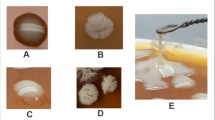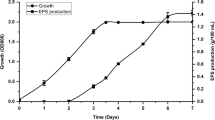Abstract
In the present study, we aimed to extract, purify, analyze monosaccharide composition of exopolysaccharide (EPS) produced by Halorubrum sp. TBZ112 (KCTC 4203 and IBRC-M 10773) and also to evaluate its possible antiproliferative activity against human gastric cancer (MKN-45) cell line and its biocompatibility effect on normal cells using human dermal fibroblast (HDF) cell line. Average molecular weight and monosaccharide composition were determined by high-pressure size exclusion chromatography (HPSEC) with multi-angle laser light scattering (MALLS) and high-pressure anion exchange chromatography (HPAEC), respectively. Fourier transform infrared (FTIR) spectroscopy was used for the partial characterization of the EPS. The EPS effect on the cell proliferation and viability of MKN-45 and HDF cells was assessed using 3-(4,5-dimethylthiazol-2-yl)-2,5-diphenyltetrazolium bromide (MTT) assay and trypan blue dye exclusion, respectively. Strain TBZ112 excreted 480 mg.l−1 of the EPS under optimal growth conditions. The EPS had a molecular weight of 5.052 kDa and was a heteropolysaccharide containing ten moieties mainly composed of mannose (19.95%), glucosamine (15.55%), galacturonic acid (15.43%), arabinose (12.24%), and glucuronic acid (12.05%). No significant difference of the EPS treatments on the proliferation activity of MKN-45 and HDF cells were observed (P > 0.05). For the first time, the EPS from Halorubrum sp. TBZ112, an extremely halophilic archaeon related to Halorubrum genus, was isolated and chemically characterized. The EPS from Halorubrum sp. TBZ112 possesses a relatively low molecular weight and might be applied as a biocompatible compound. More investigations are needed to determine other biological activities of the EPS along with further details of its chemical structure.


Similar content being viewed by others
References
Antón J, Meseguer I, Rodriguez-Valera F (1988) Production of an extracellular polysaccharide by Haloferax mediterranei. Appl Environ Microbiol 54:2381–2386
Arena A, Gugliandolo C, Stassi G, Pavone B, Iannello D, Bisignano G, Maugeri TL (2009) An exopolysaccharide produced by Geobacillus thermodenitrificans strain B3-72: antiviral activity on immunocompetent cells. Immunol Lett 123:132–137. https://doi.org/10.1016/j.imlet.2009.03.001
Arias S, Del Moral A, Ferrer MR, Tallon R, Quesada E, Bejar V (2003) Mauran, an exopolysaccharide produced by the halophilic bacterium Halomonas maura, with a novel composition and interesting properties for biotechnology. Extremophiles 7:319–326. https://doi.org/10.1007/s00792-003-0325-8
Ates O (2015) Systems biology of microbial exopolysaccharides production. Front Bioeng Biotechnol 3:200. https://doi.org/10.3389/fbioe.2015.00200
Banerjee A, Bandopadhyay R (2016) Use of dextran nanoparticle: a paradigm shift in bacterial exopolysaccharide based biomedical applications. Int J Biol Macromol 87:295–301. https://doi.org/10.1016/j.ijbiomac.2016.02.059
Banerjee A, Rudra SG, Mazumder K, Nigam V, Bandopadhyay R (2018) Structural and functional properties of exopolysaccharide excreted by a novel Bacillus anthracis (Strain PFAB2) of hot spring origin. Indian J Microbiol 58:39–50. https://doi.org/10.1007/s12088-017-0699-4
Bernardet A, Bowman J (2015) Bergey’s manual of systematics of archaea and bacteria. John Wiley & Sons, New York
Bhaskar P, Bhosle NB (2005) Microbial extracellular polymeric substances in marine biogeochemical processes. Curr Sci 88:45–53
Bitter T, Muir HM (1962) A modified uronic acid carbazole reaction. Anal Biochem 4:330–334. https://doi.org/10.1016/0003-2697(62)90095-7
Bowers KJ, Mesbah NM, Wiegel J (2009) Biodiversity of poly-extremophilic bacteria: does combining the extremes of high salt, alkaline pH and elevated temperature approach a physico-chemical boundary for life? Saline Syst 5:9. https://doi.org/10.1186/1746-1448-5-9
Bradford MM (1976) A rapid and sensitive method for the quantitation of microgram quantities of protein utilizing the principle of protein-dye binding. Anal Biochem 72:248–254. https://doi.org/10.1016/0003-2697(76)90527-3
Chen YT, Yuan Q, Shan LT, Lin MA, Cheng DQ, Li CY (2013) Antitumor activity of bacterial exopolysaccharides from the endophyte Bacillus amyloliquefaciens sp. isolated from Ophiopogon japonicus. Oncol Lett 5:1787–1792. https://doi.org/10.3892/ol.2013.1284
Delbarre-Ladrat C, Sinquin C, Lebellenger L, Zykwinska A, Colliec-Jouault S (2014) Exopolysaccharides produced by marine bacteria and their applications as glycosaminoglycan-like molecules. Front Chem 2:85
DuBois M, Gilles KA, Hamilton JK, Rebers PT, Smith F (1956) Colorimetric method for determination of sugars and related substances. Anal Chem 28:350–356. https://doi.org/10.1021/ac60111a017
Fazeli MR, Tofighi H, Samadi N, Jamalifar H (2006) Effects of salinity on beta-carotene production by Dunaliella tertiolecta DCCBC26 isolated from the Urmia salt lake, north of Iran. Bioresour Technol 97:2453–2456. https://doi.org/10.1016/j.biortech.2005.10.037
Finore I, Di Donato P, Mastascusa V, Nicolaus B, Poli A (2014) Fermentation technologies for the optimization of marine microbial exopolysaccharide production. Mar Drugs 12:3005–3024
Gatea F, Teodor ED, Seciu AM, Radu LE (2017) Monosaccharides composition and cytostatic activity of polysaccharide fraction of Phemeranthus Confertiflorus L. Farmacia 65:796–801
Goncalves Mdos S et al (2014) Anti-biofilm activity: a function of Klebsiella pneumoniae capsular polysaccharide PLoS One 9:e99995. https://doi.org/10.1371/journal.pone.0099995
Hamidi M, Nazemyieh H, Hejazi MA, Hejazi MS (2014) Optimization of cell growth and carotenoid production of Halorubrum sp. TBZ112 through statistical experimental methods. Iran J Public Health 43:242
Hamidi M, Hejazi MS, Nazemyieh H, Hejazi MA, Naziri D (2017) Halorubrum Sp. TBZ112, an extremely halophilic carotenoid-producing archaeon isolated from Urmia Lake Pharm Sci 23:150–158. https://doi.org/10.15171/PS.2017.22
Haroun-Bouhedja F, Ellouali M, Sinquin C, Boisson-Vidal C (2000) Relationship between sulfate groups and biological activities of fucans. Thromb Res 100:453–459. https://doi.org/10.1016/S0049-3848(00)00338-8
Hussain A, Zia KM, Tabasum S, Noreen A, Ali M, Iqbal R, Zuber M (2017) Blends and composites of exopolysaccharides; properties and applications: a review. Int J Biol Macromol 94:10–27. https://doi.org/10.1016/j.ijbiomac.2016.09.104
Koyanagi S, Tanigawa N, Nakagawa H, Soeda S, Shimeno H (2003) Oversulfation of fucoidan enhances its anti-angiogenic and antitumor activities. Biochem Pharmacol 65:173–179. https://doi.org/10.1016/S0006-2952(02)01478-8
Llamas I, Amjres H, Mata JA, Quesada E, Béjar V (2012) The potential biotechnological applications of the exopolysaccharide produced by the Halophilic Bacterium Halomonas almeriensis. Molecules 17:7103. https://doi.org/10.3390/molecules17067103
Lu Y, Lu H, Wang S, Han J, Xiang H, Jin C (2017) An Acidic Exopolysaccharide from Haloarcula hispanica ATCC33960 and two genes responsible for its synthesis. Archaea 2017:5842958. https://doi.org/10.1155/2017/5842958
Mishra A, Jha B (2013) Microbial exopolysaccharides. In: Rosenberg E, DeLong EF, Lory S, Stackebrandt E, Thompson F (eds) The Prokaryotes. Springer, Berlin, Heidelberg, pp 179–192
Moscovici M (2015) Present and future medical applications of microbial exopolysaccharides. Front Microbiol. https://doi.org/10.3389/fmicb.2015.01012
Nicolaus B et al (1999) Haloarcula spp able to biosynthesize exo-and endopolymers. J Ind Microbiol Biotechnol 23:489–496. https://doi.org/10.1038/sj.jim.2900738
Oren A (2002) Halophilic microorganisms and their environments. vol 5. Springer Science & Business Media, Washington
Paramonov NA, Parolis LA, Parolis H, Boán IF, Antón J, Rodríguez-Valera F (1998) The structure of the exocellular polysaccharide produced by the Archaeon Haloferax gibbonsii (ATCC 33959). Carbohydr Res 309:89–94. https://doi.org/10.1016/S0008-6215(98)00102-5
Parolis H et al (1996) The structure of the exopolysaccharide produced by the halophilic Archaeon Haloferax mediterranei strain R4 (ATCC 33500). Carbohydr Res 295:147–156. https://doi.org/10.1016/S0008-6215(96)90134-2
Parolis LA, Parolis H, Paramonov NA, Boán IF, Antón J, Rodríguez-Valera F (1999) Structural studies on the acidic exopolysaccharide from Haloferax denitrificans ATCC 35960. Carbohydr Res 319:133–140. https://doi.org/10.1016/S0008-6215(99)00111-1
Pavia DL, Lampman GM, Kriz GS, Vyvyan JA (2008) Introduction to spectroscopy, 4 ed. Cengage Learning, New York
Poli A, Anzelmo G, Nicolaus B (2010) Bacterial exopolysaccharides from extreme marine habitats: production, characterization and biological activities. Mar Drugs 8:1779–1802. https://doi.org/10.3390/md8061779
Queiroz E et al (2017) Levan promotes antiproliferative and pro-apoptotic effects in MCF-7 breast cancer cells mediated by oxidative stress. Int J Biol Macromol 102:565–570. https://doi.org/10.1016/j.ijbiomac.2017.04.035
Rani A, Baruah R, Goyal A (2017) Physicochemical, antioxidant and biocompatible properties of chondroitin sulphate isolated from chicken keel bone for potential biomedical applications. Carbohydr Polym 159:11–19. https://doi.org/10.1016/j.carbpol.2016.12.015
Ruiz-Ruiz C et al (2011) An exopolysaccharide produced by the novel halophilic bacterium Halomonas stenophila strain B100 selectively induces apoptosis in human T leukaemia cells. Appl Microbiol Biotechnol 89:345–355. https://doi.org/10.1007/s00253-010-2886-7
Saber-Samandari S, Saber-Samandari S (2017) Biocompatible nanocomposite scaffolds based on copolymer-grafted chitosan for bone tissue engineering with drug delivery capability. Mater Sci Eng C Mater Biol Appl 75:721–732. https://doi.org/10.1016/j.msec.2017.02.112
Squillaci G et al (2016) Production and properties of an exopolysaccharide synthesized by the extreme halophilic archaeon Haloterrigena turkmenica. Appl Microbiol Biotechnol 100:613–623. https://doi.org/10.1007/s00253-015-6991-5
Staub A (1965) Removal of protein-Sevag method. In: Whistler RL (ed) Methods in carbohydrate chemistry, vol 5. Academic Press Inc., New York, pp 5–6
Sun ML et al (2014) A novel exopolysaccharide from deep-sea bacterium Zunongwangia profunda SM-A87: low-cost fermentation, moisture retention, and antioxidant activities. Appl Microbiol Biotechnol 98:7437–7445. https://doi.org/10.1007/s00253-014-5839-8
Sutherland IW (1990) Biotechnology of microbial exopolysaccharides. vol 9. Cambridge University Press, Cambridge
Sutherland IW (1994) Structure-function relationships in microbial exopolysaccharides. Biotechnol Adv 12:393–448. https://doi.org/10.1016/0734-9750(94)90018-3
Thibodeau A (2005) Protecting the skin from environmental stresses with an exopolysaccharide formulation. Cosmet Toilet 120:81–90
Wang J, Hu S, Nie S, Yu Q, Xie M (2016) Reviews on mechanisms of in vitro antioxidant activity of polysaccharides. Oxid Med Cell Longev 2016:5692852. https://doi.org/10.1155/2016/5692852
Acknowledgements
This research was performed as an MSc thesis (Number 13) at School of Paramedicene, Guilan University of Medical Sciences (Rasht, Iran). This work was financially supported by the Research Deputy of Guilan University of Medical Sciences (Rasht, Iran).
Author information
Authors and Affiliations
Contributions
MH designed the research. RM, GP, CG, EP, and SF performed the research. M.H., RM, CD, KK, and FK wrote the paper. MH, CD, and KK performed analysis and interpretation of data. All authors discussed the results and participated in the manuscript revision.
Corresponding author
Ethics declarations
Conflict of interest
The authors declare that they have no conflict of interest.
Rights and permissions
About this article
Cite this article
Hamidi, M., Mirzaei, R., Delattre, C. et al. Characterization of a new exopolysaccharide produced by Halorubrum sp. TBZ112 and evaluation of its anti-proliferative effect on gastric cancer cells. 3 Biotech 9, 1 (2019). https://doi.org/10.1007/s13205-018-1515-5
Received:
Accepted:
Published:
DOI: https://doi.org/10.1007/s13205-018-1515-5




